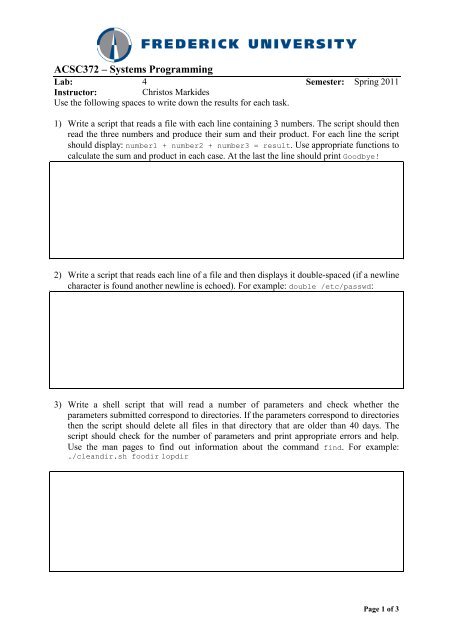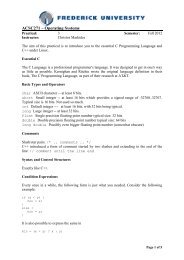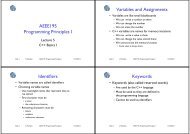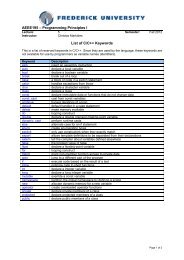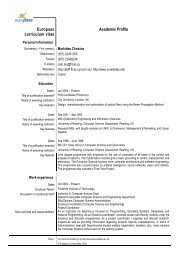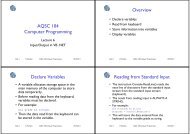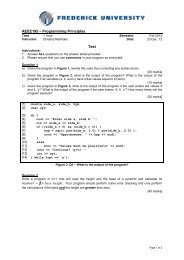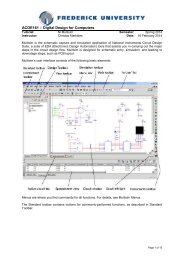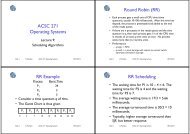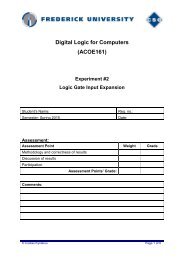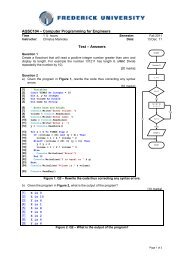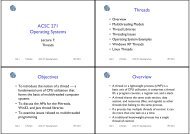Bash Script Programming II - Christos Markides
Bash Script Programming II - Christos Markides
Bash Script Programming II - Christos Markides
You also want an ePaper? Increase the reach of your titles
YUMPU automatically turns print PDFs into web optimized ePapers that Google loves.
ACSC372 – Systems <strong>Programming</strong><br />
Lab: 4 Semester: Spring 2011<br />
Instructor: <strong>Christos</strong> <strong>Markides</strong><br />
Use the following spaces to write down the results for each task.<br />
1) Write a script that reads a file with each line containing 3 numbers. The script should then<br />
read the three numbers and produce their sum and their product. For each line the script<br />
should display: number1 + number2 + number3 = result. Use appropriate functions to<br />
calculate the sum and product in each case. At the last the line should print Goodbye!<br />
2) Write a script that reads each line of a file and then displays it double-spaced (if a newline<br />
character is found another newline is echoed). For example: double /etc/passwd:<br />
3) Write a shell script that will read a number of parameters and check whether the<br />
parameters submitted correspond to directories. If the parameters correspond to directories<br />
then the script should delete all files in that directory that are older than 40 days. The<br />
script should check for the number of parameters and print appropriate errors and help.<br />
Use the man pages to find out information about the command find. For example:<br />
./cleandir.sh foodir lopdir<br />
Page 1 of 3
4) Write a shell script that will prompt the user to enter the name of a file. The script should<br />
check whether the file exists. If the file exists then the script should read the file which<br />
contains three columns of numbers and print their sums in the form of col1 + col2 +<br />
col3 = sum using a suitable function sum(). The script should print at the beginning<br />
Printing Sums and at the end End of Sums. The script should check for the number of<br />
parameters and print appropriate errors and help. Use the file numlist.csv for testing.<br />
For example: ./sums.sh<br />
Page 2 of 3
5) Write a script that will read a file (.opensessions) that contains a number of sessions<br />
that are currently running on your system. The script should then isolate and store in an<br />
array the PID of each session. The script should then present the following menu.<br />
There are 3 sessions open<br />
a) List sessions<br />
b) Make current<br />
c) Kill session<br />
d) Exit<br />
Option: a<br />
Open sessions<br />
1. 4043<br />
2. 2028<br />
3. 3592<br />
There are 3 sessions open<br />
a) List sessions<br />
c) Make current<br />
b) Kill session<br />
d) Exit<br />
Option: d<br />
There are 3 sessions open<br />
a) List sessions<br />
b) Make current<br />
c) Kill session<br />
d) Exit<br />
Option: b<br />
Enter session (0-none -3): 3<br />
[Session is now in foreground use fg cmd]<br />
[Terminate session to return script]<br />
There are 2 sessions open<br />
a) List sessions<br />
b) Make current<br />
c) Kill session<br />
d) Exit<br />
Option:<br />
There are 3 sessions open<br />
a) List sessions<br />
c) Make current<br />
b) Kill session<br />
c) Exit<br />
Option: b<br />
Enter session (0-none -3): 3<br />
Enter session to kill: 2<br />
[kill session]<br />
There are 2 sessions open<br />
a) List sessions<br />
c) Make current<br />
b) Kill session<br />
c) Exit<br />
Option:<br />
The script should cater for cases that the number of sessions open are 0 or in the even that the<br />
user has selected to kill or to bring to foreground a session that does not exist (anymore) in the<br />
array:<br />
cat .opensessions<br />
4043.pts-0.hpc8 (Detached)<br />
2028.pts-0.hpc8 (Detached)<br />
3592.pts-0.hpc8 (Detached)<br />
[christos@hpc8 ~]$ ./countsessions<br />
There are 3 sessions open<br />
a) List sessions<br />
b) Make current<br />
c) Kill session<br />
d) Exit<br />
Option: a<br />
Page 3 of 3


